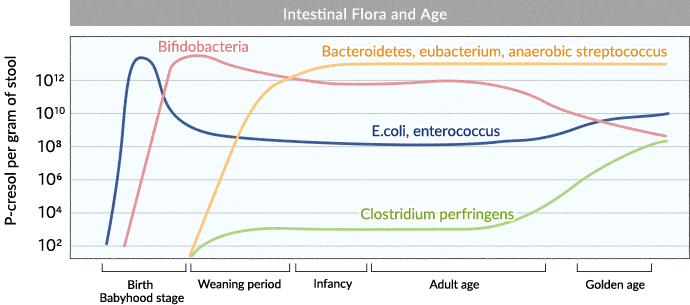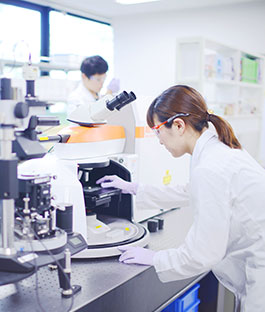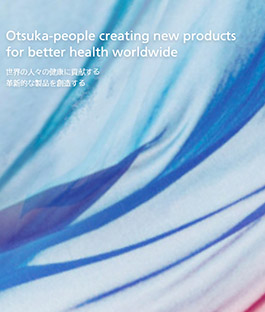Typical intestinal bacteria
There are three types of intestinal bacteria: beneficial, harmful, and opportunistic, each with different actions and effects on the body. The proportions of these intestinal bacteria change with age.
Beneficial, harmful, and opportunistic bacteria
Typical intestinal bacteria are classified according to their actions into three types.
Good bacteria have health maintenance and anti-aging effects such as aiding digestion and absorption, and stimulating immunity.
Representative examples are bifidobacteria and lactic acid bacteria.
In contrast, bad bacteria have adverse effects on the body. Representative examples include Clostridium perfringens, Staphylococcus, and Escherichia coli (E. coli; toxic strain). They inhibit health by triggering disease and promoting aging.
Opportunistic bacteria cause no trouble when you are healthy, but have adverse effects upon the intestines when the body is weak. Representative examples include Bacteroidetes, E. coli (nontoxic strain), and Streptococcus.
Good bacteria
| Representative bacteria | Bifidobacteria, lactic acid bacteria |
|---|---|
| Action | Vitamin synthesis, digestion and absorption assistance, infection prevention, immunity stimulation |
| Effects on body | Health maintenance |
Bad bacteria
| Representative bacteria | Staphylococcus, clostridium perfringens, E.coli (toxic strain) |
|---|---|
| Action | Intestinal putrefaction, production of bacterial toxin, production of carcinogenic substances, gas production |
| Effects on body | Trigger of disease |
Opportunistic bacteria
| Representative bacteria | Bacteroidetes, E.coli (nontoxic strain), streptococcus |
|---|---|
| Effects on body | No trouble when healthy, but have adverse actions inside the intestines when the body is weak |
Changes in intestinal bacteria with age
Bacterial groups in the intestines change with age-the percentage of bad bacteria increases as you grow older.
A fetus in the womb is kept in a sterile environment. When the baby drinks breast milk, bifidobacteria start to grow, using the lactose and galactooligosaccharides in breast milk as a source of nutrition. A baby's stool is yellowish and does not smel because its intestinal environment is dominated by bifidobacteria.
From the weaning period onwards, bacterial flora*1 change to that of an adult as the baby starts to eat baby food. In adults, bifidobacteria account for 10-20% of intestinal bacteria.
In most elderly, bifidobacteria will have decreased in most cases and bad bacteria such as clostridium perfringens, which are not detected in youth, have a high probability of being detected.
- *1Aggregation of beneficial, harmful, and opportunistic bacteria.

The balance of good bacteria, bad bacteria and opportunistic bacteria changes with physical condition and age.
For maintaining good health, it is necessary to create a healthy intestinal environment with good bacteria.






